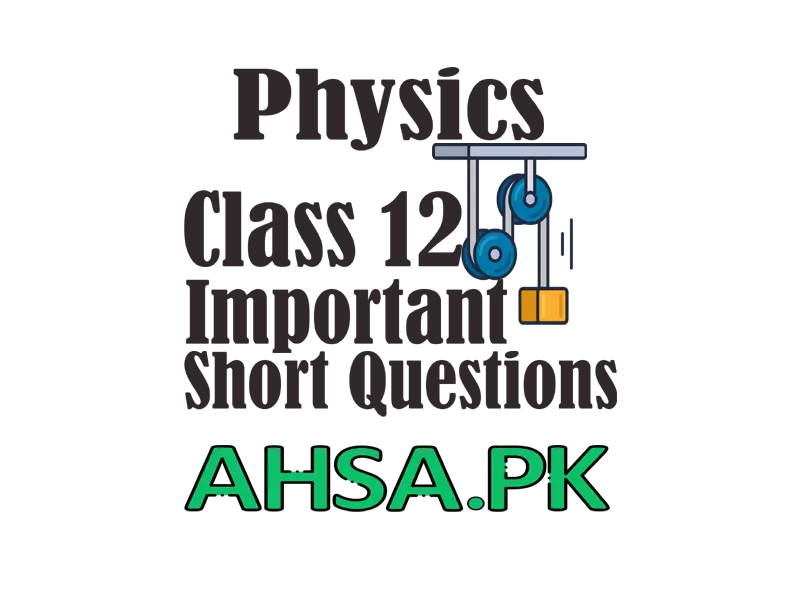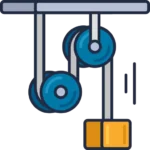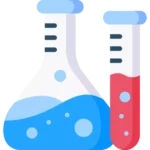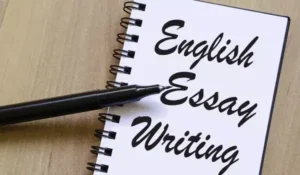These are 2nd Year Physics Important Short Questions. These Physics Guess Papers for Class 12 are according to Punjab Board previous exams. Prepare these questions thoroughly to get the best marks in board exams. If you have any queries then ask @ahsa.pk any time.
2nd Year Physics Important Short Questions
- What is the energy of a photon in a beam of infrared radiation of wavelength 1240 nm?
- If 23392U decays twice by α – emission, what is the resulting isotope?
- Define mass defect and binding energy.
- How much energy is released when I amu convened into energy?
- What do you understand by radioactivity?
- Differentiate between parent and daughter elements?
- What is radioactive decay? Give an example.
- What is natural radioactivity? Name types of radiations emitted from radioactive elements.
- What will be the change in mass number and charge number during alpha decay?
- What are artificial radioactive elements?
- Define half-life and discuss its dependence.
- Define the half-life of radioactive elements. How can you estimate the number of undecayed atoms after n half-lives?
- How α and β particles may ionize an atom without directly hitting the electrons? Explain.
- Define fluorescence. Name two fluorescence substances.
- Describe a brief account of the interaction of various types of radiations with matter.
- Write down two advantages of a solid-state detector over the Geiger Muller Counter.
- Discuss the advantages and disadvantages of nuclear power compared to the use of fossil fuel-generated power.
- Define nuclear fission. Give two examples of such a reaction.
- Differentiate between controlled and m-controlled chain reactions?
- Write down two expected nuclear reactions for fission to indicate daughter nuclei.
- Explain briefly the fission chain reaction.
- Distinguish between nuclear fission and nuclear fusion.
- State the advantages and disadvantages of nuclear power.
- Write any two uses of radiography.
- What is a radioactive tracer? Describe the application in medicine and agriculture.
- Differentiate between Baryons and Mesons.
- Protons and neutrons are formed by what type of quarks? Show the diagram.
- Differentiate between Hadrons and Laptons.
- Write postulates on Bohr’s model of H-atom.
- Find speed of electron in the 1st Bohr orbit.
- Differentiate between characteristics of X-rays and Continuous X-rays.
- Differentiate between normal population and population inversion?
- Explain de-Broglie’s interpretation of Bohr’s orbit to show that mvr = nh/2p
- Derive the expression for the wavelength of the hydrogen spectrum using Bohr’s third postulate.
- Briefly describe the nature of radiations emitted from a radioactive material.
- What are black body radiations and how can you get a black body?
- Give the Planck’s explanation of the radiation emitted by a black body.
- Photoelectric effect gives the evidence of the particle nature of light. Explain it how?
- What do you understand by work function and stopping potential?
- Define Compton Effect. Write formula of Compton shift for scattering angle θ?
- What is the Compton shift in the wavelength of a photon scattered at an angle of 90o?
- What is wave particle duality? Give its one practical use.
- What changes Heisenberg made in his uncertainty principles after more careful calculations?
- Give the two statements of uncertainty principle.
- The life time of an electron in an excited state is 10 s. What is its uncertainty in energy during this time?
- Draw and discuss the characteristic curve of photocurrent vs applied voltage for light of different frequencies.
- How the curve of photocurrent and applied voltage varies for different intensities of monochromatic light? Explain
- State de-Broglie hypothesis and give its formula.
- What is the potential barrier? What is the value of potential barrier of Si and Ge?
- What is the effect of forward and reverse biassing of a diode on the width of depletion region?
- What is the role of potential barrier in a diode? How is it formed in a diode?
- Draw a circuit used for full wave rectification. Show direction of current in the circuit when positive half of input AC cycle passes through it.
- Describe the variation of reverse current with the intensity of light exposed on a photo diode using graph.
- What is the biasing requirement of the junctions of an n-p-n transistor for its normal operation?
- Discuss the types of a transistor.
- Describe the main characteristics of the three regions of a transistor.
- Define voltage gain of a transistor as an amplifier. Give its mathematical expression.
- Define input and output resistance of an operational amplifier.
- Define Open Loop gain of an operational amplifier. Also give its formula.
- Write the equation for the gain of inverting amplifier.
- Differentiate between half wave and full wave rectification?
- Draw the circuit diagram of operational amplifier as an inverting amplifier and label it.
- Differentiate between ductile and brittle substances. Give an example for each?
- Define ultimate tensile stress UTS.
- Define Modulus of Elasticity. Write down its three kinds.
- Compare the electrical behavior of conductor and semiconductor in terms of energy band theory?
- Differentiate between Insulators and Conductors.
- What are the two main differences between conductors and semiconductors?
- Carbon, Silicon and Germanium have four valence electrons. Why Carbon is insulator while Silicon and Germanium are Semiconductors?
- What is the difference between intrinsic and extrinsic semiconductors?
- Differentiate between p – type semiconductor and n – type semiconductor.
- Show that how n- type semiconductor is formed from pure silicon with schematic diagram.
- What is high temperature superconductor? Give an example.
- Distinguish between soft magnetic materials and hard magnetic materials?
- Energy dissipated per cycle for steel is more as compared to iron. Why?
- What is doping? What is its effect on the electrical behaviour semiconductor?
- Why is power dissipated zero in pure inductive and pure conductive circuit?
- Show that for RC circuit. the angle between current and voltage is given as θ=tan-11/ꞷRC.
- How can you establish the formula for power in A.C circuits ‘? Explain the role of power factor in it?
- What is the condition of resonance for RLC series resonance circuit? Also derive relation of resonant frequency.
- At resonance frequency the impedance of RLC series circuit is only resistive. Why?
- Write the condition under which electromagnetic waves are produced from a source?
- Draw and discuss current frequency diagram of RLC series resonance circuit.
- State Faraday’s law electromagnetic induction?
- Discuss briefly that Lenz law is exactly in accordance with the law of conversation of energy.
- State the Lenz’s law.
- On what factors the mutual inductance of two coils depends?
- Define mutual induction and mutual inductance.
- Define self-induction and mutual induction?
- What are the factors on which maximum value ε0 of emf induced across terminals or armature of an A.C generator depend?
- What happen to the current of a circuit if a load resistance of the circuits is much less than the power transferred?
- Write characteristics of electric field lines?
- How sharks locate their prey? Explain briefly.
- Define electric flux. Write its SI units?
- What is the orientation of the surface in an electric field to m maximum flux through it?
- What are the factors upon which the electric flux depends?
- What is strength of electric field inside a hollow charged sphere and why?
- What is difference between electrical potential energy and electrical potential difference?
- What is meant by EEG and ERG?
- Define electric potential difference with units?
- Show that E = Dv/Dr.
- A particle carrying a charge of Sc falls through a potential difference of 10.0V. What will be then energy acquired by it?
- Differentiate between electrical potential difference and electric potential at a point?
- Show that I CV = 1.6 x 10-19 J.
- Define electrons volt. Give its mathematical form?
- Convert 1 joule into electron – volt?
- A particle carrying a charge of 2e falls through a potential difference of 3.0V. Calculate the energy acquired by it?
- When the electrons fall through a potential difference of 1.0 Volt. Find its energy in electron volts?
- Write the differences between electrical and gravitational force?
- Why does capacitance of a capacitor increase when a dielectric material is inserted between its plates ‘?
- How will capacitance of parallel plate capacitor be affected if area of plates is doubled and separation between them is halved?
- Define dielectric constant and write its formula?
- Verify that an ohm times Farad is equivalent to second?
- What depend on the slow or fast charging and discharging of a capacitor?
- What is time constant?
- How much is the amount of charge at start of discharging of capacitor and start of charging of a capacitor?
- Define temperature coefficient of resistance. Give its unit?
- Can you describe some substances whose resistance decrease with increase of temperature?
- What is meant by Tolerance? Also give one example.
- Find the resistance of a resistor with red, green, orange and gold respective brands. What is its tolerance?
- A potential difference is applied across the ends of a copper wire. What is the effect on the drift velocity of the free electrons by increasing the potential difference?
- Why the terminal potential difference of a battery decreases when the current drawn from it is increased?
- What is the difference between electromotive force and terminal potential difference?
- A potential difference is applied across the ends of a copper wire. What is the effect on the drift velocity of free electrons by decrease in the length and temperature of the wire?
- Briefly describe the current through a metallic conductor and drift velocity?
- Why does no current pass through galvanometer in a balanced wheat stone bridge although the two keys in the circuit arc closed?
- Define Electric power. Write its three equations for power dissipation in a resistor.
- Define Kirchhoff 2nd rule.
- Distinguish between magnetic flux and magnetic flux density. Write their SI units?
- Define magnetic flux density and give its equation.
- Mention the factors upon which magnetic flux depends.
- Why is B non-zero outside a solenoid?
- State Ampere’s law. Write down its formula?
- Briefly give the function of filament, cathode, grid and plates in C.R.O.?
- Write any two uses of CRO.
- What is the function of grid in cathode ray oscilloscope?
- Draw Saw tooth voltage wave form and describe it?
- What is Time Base Generator?
- How can you explain the wavefront of various voltages formed in CRO?
- How the beam of electron is focused on the screen of CRO? Show it with diagram.
Guess Papers for Class 12
Schemes of Class 12










